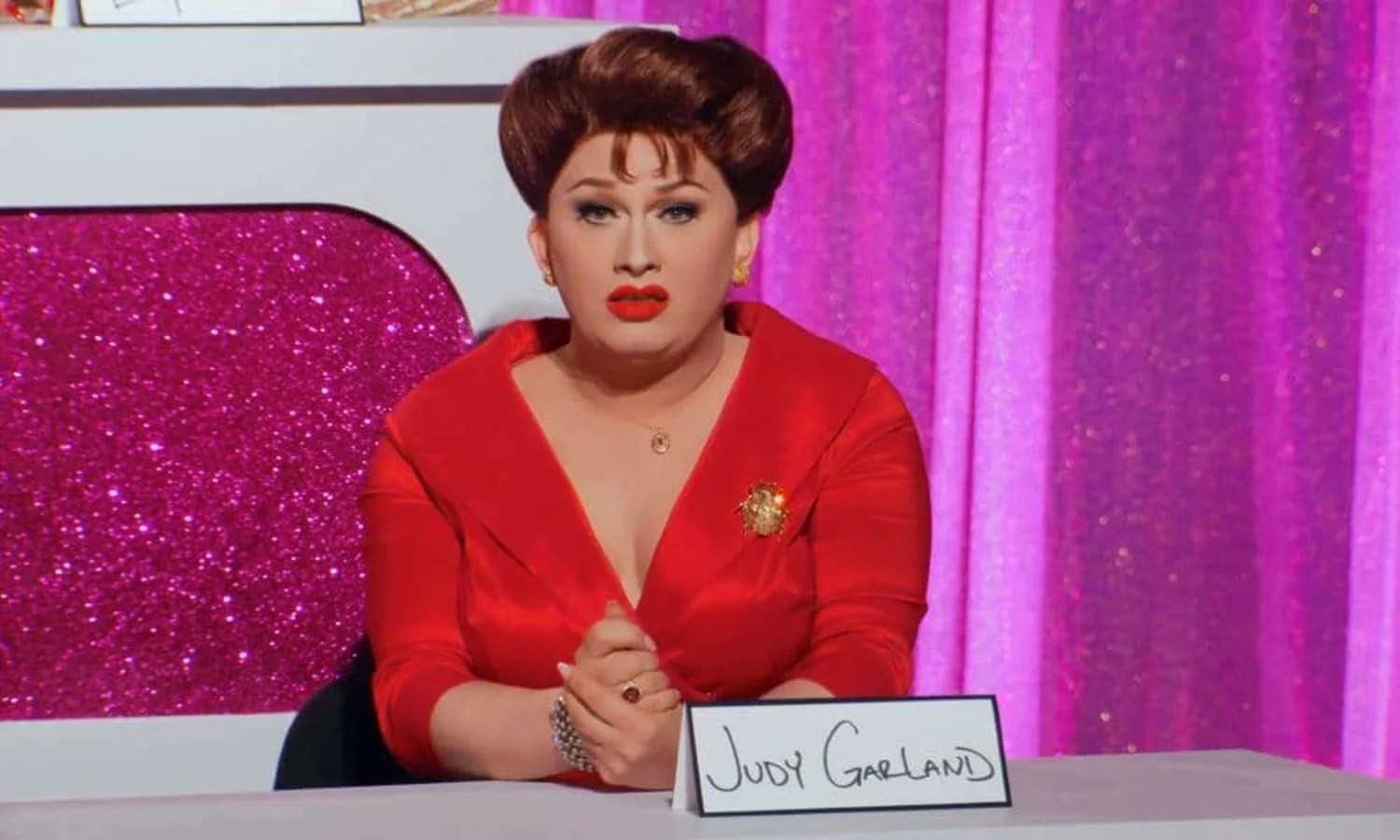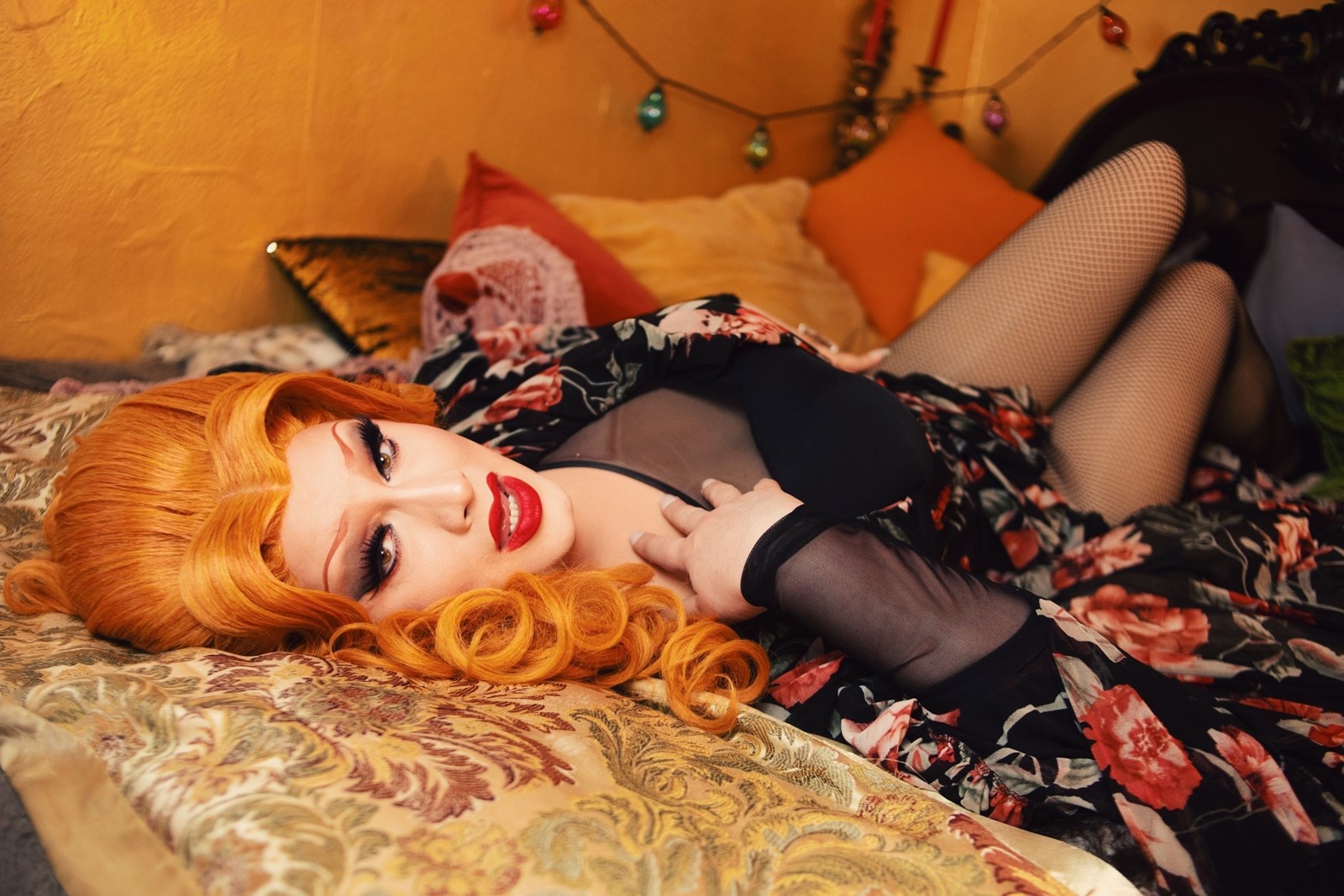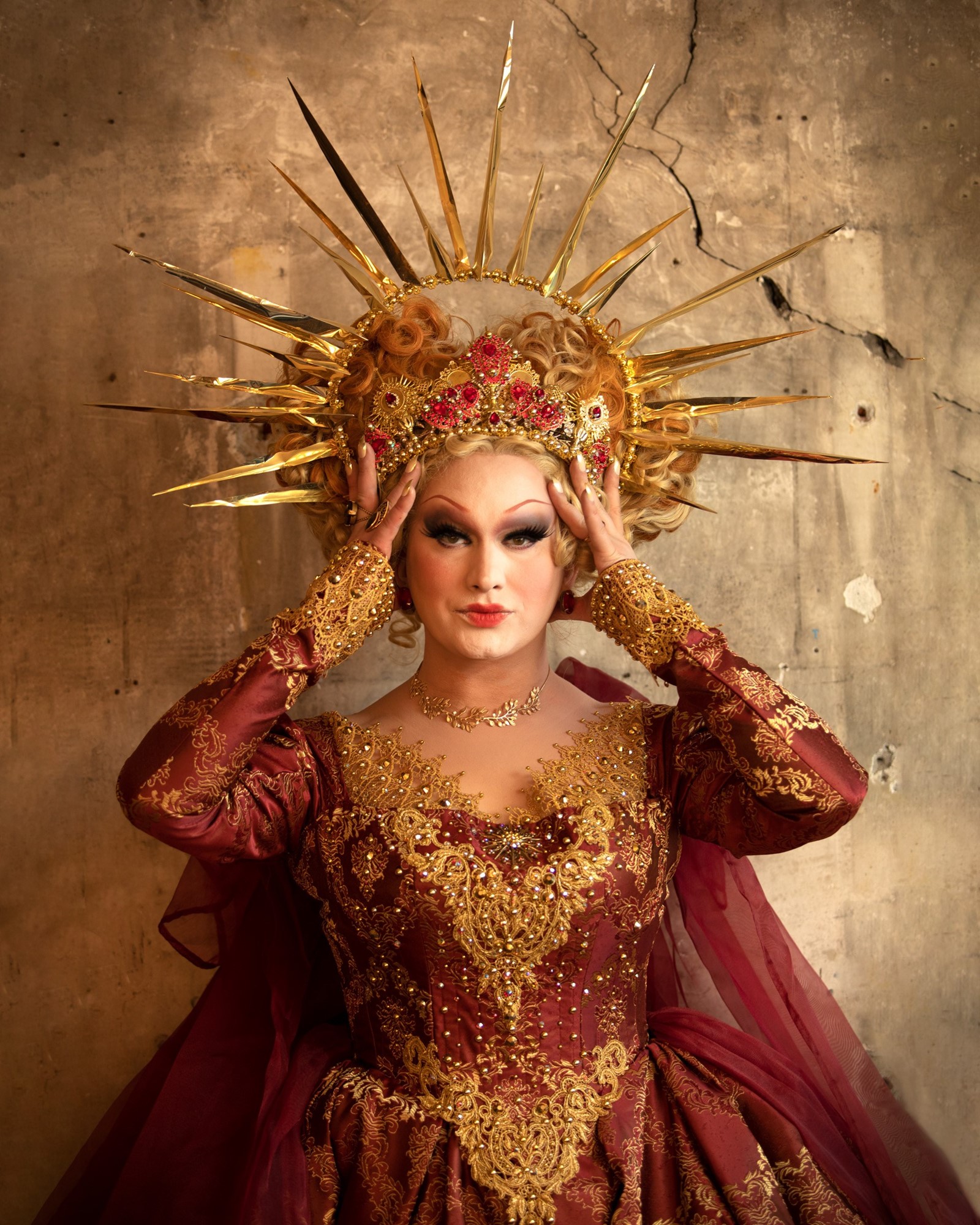Jinkx Monsoon wants to talk about therapy. She’s speaking to me via Zoom from her home in Portland, Oregon, in front of what is surely her closet, on the eve of the RuPaul’s Drag Race All Stars finale. This Friday concludes the first-ever all-winners’ season from the televised drag empire, and she is – based on her track record of weekly challenge wins, and on the way these things feel, cosmically speaking – heavily favoured to win it. We haven’t yet seen what it looks like for a previous winner to ascend to something beyond a winner, or for a crowned queen to be meta-crowned Queen of All Queens within the pantheon. But we’re about to. And Jinkx’s star is rising.
Which works well, because Jinkx Monsoon also wants to talk about witchcraft, and astrology, and star stuff (she’s a Virgo, by the way). “I think of witchcraft as a supplement to my therapy,” she explains, after quickly clarifying that she “absolutely believe[s] in science.” She calls witchcraft her “philosophy,” as opposed to her religion. “It’s all about mindfulness,” she says. “How you affect your environment, how your environment affects you. The energy you’re putting out into the world.”

In speech like this, she reveals a hypersensitivity to the universe’s manoeuvrings. “I’m a sensitive person. I wear my heart on my sleeve,” she tells me, before also calling herself a “perfectionist, type-A performing personality.” It’s likely this very combination of traits that got her the Drag Race crown the first time, back in 2013 when she was just 24 years old. She was recently out of art school then, “plucked out of obscurity,” but was already as clear-eyed about the art form as just about anyone who has run the RuPaul gauntlet before or since. She’s a trained theatrical and vocal performer whose identifiable brand of comedic, character-driven drag theatre knowingly draws from deep in the history – back to commedia dell’arte clown forms, which she says is “what every drag queen does, whether she knows that’s what she’s doing or not.” The performative elements of her drag have a studied polish about them; they deliver with the reliability of good old-fashioned craftsmanship.
“I think I knew that I was ready, going from a Pacific Northwest local queen to a nationally and internationally known drag queen” – Jinkx Monsoon
On the day we speak, she’s about to leave for a tour of Australia and New Zealand with Drag Race sister and holiday show co-creator BenDeLaCreme. She’s been doing All Stars-related interviews all afternoon, and she’s in the midst of releasing her extremely witchy cover of “Strange Magic.” The demands on her time are growing more insistent as the finale draws near, which would presumably be a lot for any person, let alone a person who can be a self-identified “bundle of nerves.” But on Zoom, there is an air of calm about her. She speaks with measured care, laughs a lot, and occasionally takes a pause to vape.
Jinkx the persona is a brassy, boozy, MILF-y starlet-who-couldn’t, a middle-aged single mom who craves the spotlight, clings to fading youth, and lives on the verge. She’s an amalgam of childhood cultural fascinations, including old Hollywood, vaudeville, I Love Lucy, Death Becomes Her, and Absolutely Fabulous, among others. Ab Fab’s chronically drunk and relevance-obsessed Edina Monsoon is the character’s namesake: “I wouldn’t say that I mimic Jennifer Saunders in everything that I do,” she muses, “but you can see the influence pretty much from start to finish.” In creating the persona, she also drew heavily from figures in her own household: she was raised, along with her younger siblings, by her mother, an aunt, and her grandmother, all of whom reportedly crop up in her work. It was her mother, though, who most directly inspired Jinkx’s characterisation. “Jinkx is a single mother, the odds are stacked against her, she’s frantic, she’s chaotic,” she summarises. “It wasn’t until later, looking back, that I realised I was just doing a funny, cheap impression of my mother.” She’s spoken publicly about the rocky relationship she’s had with her mother over the years, who struggled with alcoholism when Jinkx was growing up. During season five of Drag Race, Jinkx uncovered that the character was constructed, in some ways, to make sense of related trauma.

Long before first taking to the stage, she was theatrical. “My first cassette tape was the Carmen Suite,” she recalls. “I was very awkward as a kid, more or less trying to take up as little space as I could. But still, anything performative, I was always drawn to.” With access to an all-ages queer club in her native Portland, she began performing as Jinkx regularly in drag revues by the time she was 15, after a brief false start as a wind-up doll character who didn’t speak. Soon after, she moved to Seattle to attend Cornish College of the Arts. She got her sea legs in the Seattle nightlife scene while finishing school, doing a bunch of musical theatre – with turns as Angel in RENT, Moritz in Spring Awakening, and Hedwig in Hedwig and the Angry Inch – and worked as a janitor to pay for everything. Around this time, she was also developing homegrown cabaret shows like The Vaudevillians, which she wrote and performed in, in drag, alongside her longtime music partner Major Scales. In what is characteristic of both their performance style and sense of humour, The Vaudevillians centres on two jazz-age performers who froze in ice during a 1920s tour of Antarctica and are now – after having thawed out, due to global warming – trying desperately to resurrect their act. It wasn’t long before RuPaul came knocking.
“I think I knew that I was ready, going from a Pacific Northwest local queen to a nationally and internationally known drag queen,” she reflects. “I was ready for that step forward. And also, I wasn’t ready for it.” In some key ways, she was ill-prepared the first time. She didn’t even have an Instagram account before season five of Drag Race, which made the onslaught of worldwide attention that followed her win something of a culture shock. It required setting new boundaries – like learning to thoughtfully navigate, or sometimes completely sidestep, the comments section. “As someone who was trained to take critiques on my work, I first thought, oh, I have to read the comments,” she says. “I thought, that’s part of creating art: you take in the critiques and you learn what you can from them. But I really had to learn that there’s a difference between people critiquing the artwork and people just saying shit.” Her last few words contort into her distinctive full-throated giggle.
Some of the shit people say relates to her aesthetic sensibility in drag: one longstanding narrative insists she is not on par with her contemporaries in terms of the looks she produces. It is true she’s not the runway force that, say, castmate Shea Couleé is, nor was she trained by the pageant scene to turn a fully-realised, red-carpet-ready gown around in 24 hours, like we’ve now seen Trinity the Tuck do multiple times in competition. But she’s held her own this season, bringing old Hollywood glamour to the knitwear runway and art history cheekiness to “What Lies Beneath,” a multi-reveal assignment for which each of her sheddable layers captured a different painter’s sensibility. For the “all glowed up” category, she came out engulfed in conceptual white silk as a witch being burned at the stake: her Diego Montoya-designed dress glowed red thanks to a hand-sewn light grid, allowing it to generate its own flames. “I really feel like every time I hit the runway on All Stars, I found that balance between delivering what [was asked of me] and staying true to the aesthetic that works for me,” she says. “Some of my fashion might still be understated, or might be a little more subdued compared to the other girls, but you can’t say it's not an evolution from season five.”

You can’t. Now almost 35, she’s undergone a decade’s worth of personal growth since she was last on television – she’s come out publicly as nonbinary and has been sober for three years, to list just two visible examples – and the drag has evolved in turn, though not in a way that feels like a rewriting. More like a deepening. Her immediately iconic Judy Garland “Snatch Game” performance was like the big sister of her Little Edie from season five: a little quicker, a little wiser, a little more magnified. All season long, the jokes have swung bigger and the characterisation has been sharper. The rules for Jinkx, the stage entity, have been so firmly and legibly set that their inevitable bending is all the more delicious for a viewer. When she’s pulled out of her correct context, like when she needs to do a TikTok dance video for a challenge, a translation is able to happen: like any carefully-formulated character with clearly-articulated bounds, Jinkx is able to make sense as Jinkx, doing a TikTok dance video (she placed that week, too).
“Theatre, live entertainment, character creation, storytelling – that’s what got me passionate about drag and creating art” – Jinkx Monsoon
Contemporary mainstream drag, heralded on to our laptops largely by RuPaul, among others, can be obsessive about branding, makeup, and fashion – those elements of the art form that can be communicated easily over the internet. There’s not always a ton of room for analog performance. “Theatre, live entertainment, character creation, storytelling – that’s what got me passionate about drag and creating art,” Jinkx says. “Right after winning Drag Race, it was conveyed to me that that’s not the lucrative or easy route to take. Of course, I do my fair share of bar appearances and club gigs, but it would be foolish of me to try to do something I’m not passionate about. I might be reaching a wider audience, but reaching them with something that isn’t actually my superpower.” This assuredness of her value and her place within the larger drag world did not come naturally or overnight. She credits keeping the right people close to her for many years. “I still work with all the same people that I worked with before Drag Race,” she says. “Those are the people that keep me grounded as to why I started this in the first place.”
There are also her personal wellness practices, which help with groundedness. “You want to know how I do it? Therapy and witchcraft!” she says, performing the tiniest bit, before continuing: “Sometimes, there might not be an action that you can take to solve a problem. You can’t really do much about feelings other than try to find the peace within yourself. I take the time in the day to think about where I’m at emotionally, and how I can get myself to where I want to be emotionally.” Therapy, like witchcraft, can be about energetic reset, a reconfiguration of internal systems. Becoming more aligned with yourself.
“I’ll tell you a mantra that I’ve been living with,” she says, at one point. “Jaida [Essence Hall] would say all the time while we were filming All Stars: two things can be true.” That certainly seems to apply. There is a weird disconnect between her gentle earnestness and the international fame she earned via reality competition, between her wide appeal and cabaret-style drag musical commentary on climate change. There is something twofold about the high-brow references she can pull seamlessly into very accessible and even absurdist work – work that is, itself, both a celebration, a joyful casting off of what constricts us “from cradle to tomb,” and a vehicle for processing. Drag is inherently a few things at once, and therefore lends itself nicely to people who are naturally manifold. In a moment she recalls as pivotal for her development as an artist, a teacher at Cornish told her that, when building a character, you can start with the internal facets and let them inform the external presentation, or vice versa – it’s really all the same, process-wise, because each thing is both things.
But Jinkx, the character, is one precise alloy – always, coherently, remarkably. “I’m borrowing a phrase from Chad Michaels, but what you’re seeing now is galvanised Jinkx,” she says when I ask about the development of the character since the beginning. “You’re seeing Jinkx with her battle scars, and you’re seeing Jinkx in her suit of armour. She’s a more refined, more polished, more honed-in-on character.” She’s not, though, an onstage creation distinct from who she was ten years ago, or probably even 20 years ago; her edges are more defined, if anything, but she’s not altered in any fundamental ways. “On season five, I knew who I was,” she insists, and that’s long been clear. It’s always rootedness – witchcraft and therapy, maybe, or a digging in of the heels when it comes to what we do best – that allows for growth upwards.
